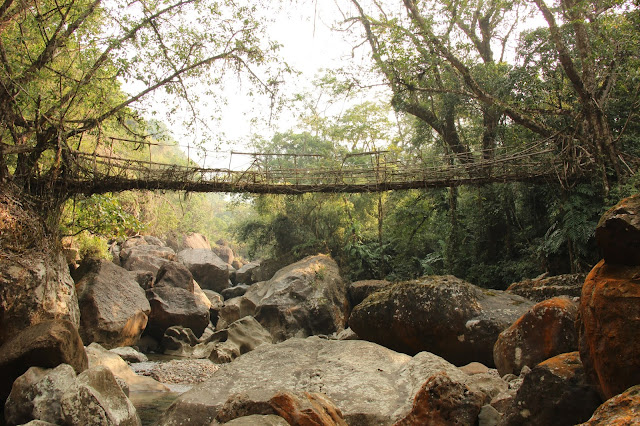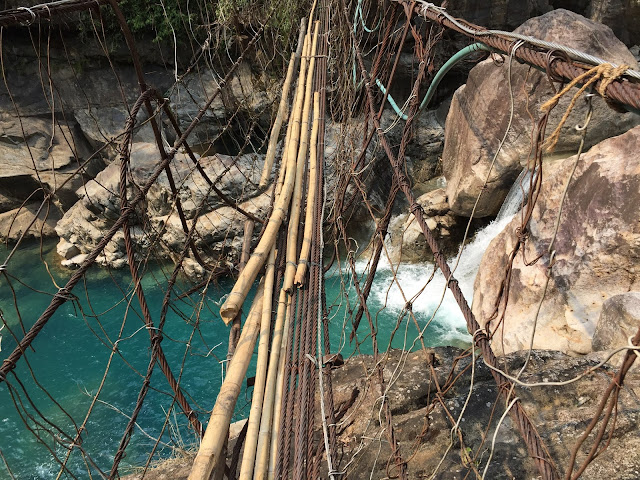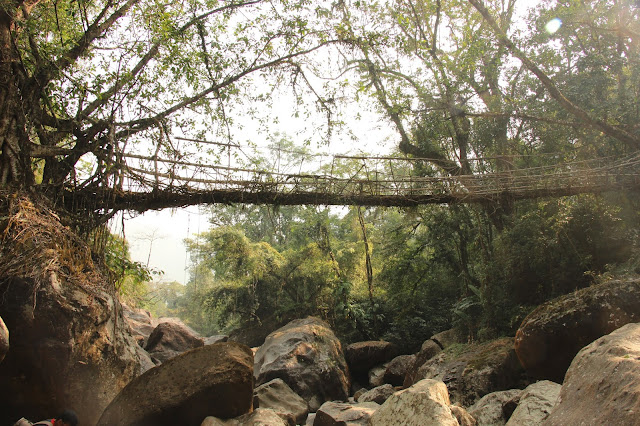Amidst the lush Khasi mountains lies
the small village of Nongriat, famed for its double decker living root
bridge. The trek to the root bridge is approximately 2500 steps
downhill, which takes about a couple of hours if you are an amateur
trekker.
 |
| Double decker root bridge |
My husband and I were set out to leave
at 7 a.m. from our resort. The resort had booked us a cab to drop us at
the trekking start point just 15 minutes down the resort, and
provided us with a map to the root bridge.
Initially, we got to see a couple of
houses along the trail but from then on it was just us. Very rarely
we came across one or two souls here and there at some small shops
that sold water, eggs and biscuits for trekkers. But apart from
those, the trail was pretty much secluded. Come to think of it, it
was a bit daring of us to venture into a forest with no guide, with a
hand drawing from the resort that guided us as a map. Don't take me
wrong, there were guides who offered to provide their service but we
wanted to explore on our own so we called in our gutsy chits that
day.
The trek downhill as you can assume was
easy initially since it is downhill but after a point it got a bit
tiring. I had so little exercise in city-life before, that my
stamina didn't support my enthusiasm but nevertheless I went on. My
husband despite being unhappy about the trekking in the travel plan,
pursued relentlessly with all his might and motivated me every time I
took a break.
A few minutes down the stairs, we came
across the longest living root bridge in the world. You have to take a
two-minute detour to Tyrna village to witness this sleek piece of
living roots fashioned into a bridge by the Khasi tribes. The
Umshiang river flowing under the bridge adds to the aesthetics of the
scenery and compliments the elegant bridge giving the entire scene an
elegant look. |
| View of the longest root bridge from the trail |
 |
| World's longest root bridge as of 2017 |
After overwhelming our eyes with the
world's longest living root bridge, we continued back on track. Along
the way, we came across two steel bridges, really thin as in it
looked like only one person can walk at a time lest it would give
away at the joints and put us straight into the rushing river under
it. While we were contemplating how to cross this without shaking it
or landing straight in heavens, one of the villagers with a heavy load
of cement on his head walked right past us on the steel bridge
without holding the sides as if he was walking on a treadmill. He
didn't bat an eye to our apprehensions. We simply followed him and
tried to be brave and crossed the bridge only to find another similar
but what look like a more dangerously rusty steel bridge. I crossed
that too by comforting myself with the views of beauty surrounding me.
 |
| Steel bridge |
 |
| Villager's day to day |
 |
| Second (so-called) steel bridge |
We kept following the steps with Khasi
mountains at the backdrop listening to birds chirping around us,
trees dancing with the breeze, Khasi mountains peering down at our
lonely selves, crystal blue waters of the river gushing in the
valleys gulping our echoing voices. After what seemed like an
eternity of long hike amidst the dense forest and the fear of being
attacked by a wild animal at any point, my legs were about to give up
when we saw some civilization at Nongriat village. |
Tempting blue waters
|
All the efforts, the exhaustion and the
ordeal of trekking for 3000 ft vanished the minute we saw the double
decker living root bridge hanging from one tree to another. This is
human race's best work with nature. With no disruption to the
ecosystem, the Khasi tribes managed to make this skill and passed it
on for generations.
 |
| Live roots making the place look lively |
The river made a small natural pool
under the bridge where we had our picnic. We relaxed a bit, met with
fellow travellers from the resort and headed back at noon. The steps
from the double decker bridge led to rainbow falls and a naturally
formed swimming pool but we saved that for another trip as we did not
want to lost time on trekking back to base. It was a three-hour
climb uphill and we did not want to do it in the dark.The trek back was not as motivating and
I took a lot of breaks in between which made it even more strenuous.
The birds had stopped chirping, the trees stood still and the
mountains bid us a sad goodbye as we went back to our resort, but not
before turning back and clicking a picture of the path I left behind.
 |
| Where it all began |
 |
| Look back and capture what you leave behind |
Little things: Have a relaxed fish pedicure at the pool under the double decker root bridge. If you are not planning to trek further to rainbow falls, this is the best way to enjoy the serenity of the environment. Trust me, after a long trek this will feel very calming.
 |
| Fish pedicure at the tiny waterfalls |
Eat out: Have boiled eggs in the small shops along the way to gear up for the trek.
Tip from the tip: Pack light. Drink less water, for obvious reasons. Even though there are restrooms in the villages on the way, they are so far apart during the trek and it consumes time to take a detour. Start early, around 6 a.m and make sure the return uphill is around noon or 1 p.m maximum. Don't push it further as Meghalaya is in the east and the Sun sets around 5.30 p.m. Carry bills of small denominator, you won't get change from the local shops along the trek.
Photo Credits: Srivathsan Ravi & Me
Visit: 27.02.2017
















Nice content travel guide 👍
ReplyDelete